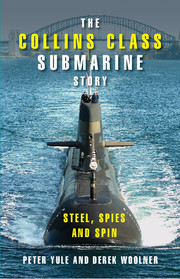Book contents
- Frontmatter
- Contents
- List of key people
- List of acronyms
- Introduction
- Part 1 You Can't Build Submarines in Australia
- Part 2 The Honeymoon Years 1987–92
- 11 ‘Keen as mustard to do a good job’: setting to work 1987–89
- 12 Designing the Collins class
- 13 Building submarines
- 14 The automated integrated vision
- 15 Steel, sonars and tiles: early technological support for the submarines
- 16 ‘On time and on budget’
- Part 3 ‘A Strange Sense of Unease” 1993–98
- Part 4 Resolution
- Notes
- Index
14 - The automated integrated vision
Published online by Cambridge University Press: 05 September 2013
- Frontmatter
- Contents
- List of key people
- List of acronyms
- Introduction
- Part 1 You Can't Build Submarines in Australia
- Part 2 The Honeymoon Years 1987–92
- 11 ‘Keen as mustard to do a good job’: setting to work 1987–89
- 12 Designing the Collins class
- 13 Building submarines
- 14 The automated integrated vision
- 15 Steel, sonars and tiles: early technological support for the submarines
- 16 ‘On time and on budget’
- Part 3 ‘A Strange Sense of Unease” 1993–98
- Part 4 Resolution
- Notes
- Index
Summary
The combat system 1987-93
The success of the weapons update program for the Oberons gave Australian submariners a vision for a fully-integrated combat system and also prompted them to consider combining this with a highly-automated ship control and management system. The automated, integrated vision became central to the requirements for the new submarines and was one of the highlights of Kim Beazley's press release on the announcement of the contracts in May 1987:
The combat system for the new submarines represents about one third of the construction cost and will be assembled in Sydney by Rockwell Ship Systems Australia…The computerised combat system will be more advanced than any yet installed in a diesel-electric submarine … All tasks can be carried out at any of the multi-function common console work stations in the control centre. There is no central processor to present a single point of failure and the data distribution system can sustain significant damage or failure and still function satisfactorily.
A prime example of the new technology is the ship management system, which greatly minimises the workload by providing computer-based control and monitoring though common multi-function consoles. It is the main reason why the crew can be reduced to 41 compared with the Oberons' 63.
- Type
- Chapter
- Information
- The Collins Class Submarine StorySteel, Spies and Spin, pp. 152 - 165Publisher: Cambridge University PressPrint publication year: 2008



